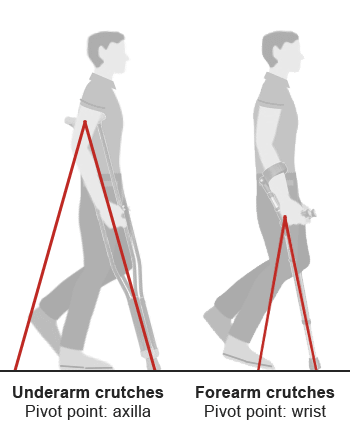




Certain markets like the U.S. primarily recommend or administer underarm crutches for short-term use, as a result of a lower-limb sprain or fracture or as a post-operative rehabilitation aid following surgery. Typically, a person would use underarm crutches anywhere from 4 to 12 weeks, with doctors and therapists sometimes recommending a walker for the first few days.
For short-term crutch users, many factors play a determining role in the type of walking aid that is prescribed and used:
1) The physician's personal preference
2) The physician's exposure to global trends and continuing further education
3) The physical, occupational or rehab therapist's personal preference and overall familiarity with available walking aids and whether he or she has had training or education abroad
4) The patient's age, weight, agility and overall strength
5) The patient's personal preference
6) The hospital, medical facility or DME (durable medical equipment) shop's inventory of available walking aids
7) The brand reliability, purchase price and profit margin.

Over the past 26 years and for short-term patients, our best estimate is that the underarm crutch is prescribed 58:1 over the forearm crutch. Simply put, in the U.S. less than 2 people out of 100 are prescribed a forearm crutch for a period of use of 12 weeks or less.
Unfortunately, studies have shown that underarm crutches do not encourage correct posture due to frequent incorrect adjustment or use (leading to compression of the radial nerve, otherwise known as “crutch palsy”) and they offer limited gait types.
Due to the underarm crutch's pivot point (or fulcrum) being much higher, on average 62% higher than that of a forearm crutch, the axillary crutch requires more energy expenditure with each step – more acceleration and deceleration – and makes it much more difficult to walk up or down stairs or steps. Purely from a perspective of convenience, underarm crutches are also longer and more cumbersome than forearm crutches.
In an American Journal of Engineering Research paper (published in 2016), authored by Adnan Miski and entitled "Design Evaluation of Crutches from an Engineering Perspective," it was noted that a late 1970's study showed that "the percentage increase in heart rate from resting rate was about 20% higher for ambulation with axillary crutches compared to ambulation with elbow crutches." The author goes on to conclude that "We have found that forearm crutches are suitable for the majority as they have minimum disadvantages compared to other crutches."
While there are many more arguments in favor of forearm crutches, our research and past 26 years of experience talking to both types of crutch users, we have come across the following three “pros” in favor of underarm crutches:
1) When fatigued, users like to be able to rest their body weight on the underarm pads — which is exactly what they shouldn't do,
2) Short-term users perceive forearm crutches as being used only by those with a long-term physical challenge, hence want to avoid the stigma — the exact opposite perception exists in most other countries.
3) Forearm crutches require more upper body strength and more practice to master.

Interestingly, in the UK and Europe, New Zealand, Australia or even Argentina, the forearm crutch prevails: “The USA predominantly prescribes the axilla crutch while the rest of world seems to prefer the forearm crutch” (posted on www.ResearchGate.net)
Over the past 25 years, we can confirm a gradual, albeit slow, acceptance of the forearm crutch as a superior walking aid even in the U.S. This shift can be seen with some of the country's most prominent and respected physicians prescribing forearm crutches after common medical procedures like hip replacement or arthroscopic knee surgery.
One of the strongest arguments in favor of the forearm crutch is also by far the most logical: doctors, therapists and patients agree that the forearm crutch is a superior walking aid for the vast majority of long-term crutch users. That argument alone should suffice in convincing anyone, especially short-term crutch users. With all due respect, that doesn't mean that there aren't specific cases or personal preferences among some users toward the axillary crutch.
Source:Walkeasy

Certain markets like the U.S. primarily recommend or administer underarm crutches for short-term use, as a result of a lower-limb sprain or fracture or as a post-operative rehabilitation aid following surgery. Typically, a person would use underarm crutches anywhere from 4 to 12 weeks, with doctors and therapists sometimes recommending a walker for the first few days.
For short-term crutch users, many factors play a determining role in the type of walking aid that is prescribed and used:
1) The physician's personal preference
2) The physician's exposure to global trends and continuing further education
3) The physical, occupational or rehab therapist's personal preference and overall familiarity with available walking aids and whether he or she has had training or education abroad
4) The patient's age, weight, agility and overall strength
5) The patient's personal preference
6) The hospital, medical facility or DME (durable medical equipment) shop's inventory of available walking aids
7) The brand reliability, purchase price and profit margin.

Over the past 26 years and for short-term patients, our best estimate is that the underarm crutch is prescribed 58:1 over the forearm crutch. Simply put, in the U.S. less than 2 people out of 100 are prescribed a forearm crutch for a period of use of 12 weeks or less.
Unfortunately, studies have shown that underarm crutches do not encourage correct posture due to frequent incorrect adjustment or use (leading to compression of the radial nerve, otherwise known as “crutch palsy”) and they offer limited gait types.
Due to the underarm crutch's pivot point (or fulcrum) being much higher, on average 62% higher than that of a forearm crutch, the axillary crutch requires more energy expenditure with each step – more acceleration and deceleration – and makes it much more difficult to walk up or down stairs or steps. Purely from a perspective of convenience, underarm crutches are also longer and more cumbersome than forearm crutches.
In an American Journal of Engineering Research paper (published in 2016), authored by Adnan Miski and entitled "Design Evaluation of Crutches from an Engineering Perspective," it was noted that a late 1970's study showed that "the percentage increase in heart rate from resting rate was about 20% higher for ambulation with axillary crutches compared to ambulation with elbow crutches." The author goes on to conclude that "We have found that forearm crutches are suitable for the majority as they have minimum disadvantages compared to other crutches."
While there are many more arguments in favor of forearm crutches, our research and past 26 years of experience talking to both types of crutch users, we have come across the following three “pros” in favor of underarm crutches:
1) When fatigued, users like to be able to rest their body weight on the underarm pads — which is exactly what they shouldn't do,
2) Short-term users perceive forearm crutches as being used only by those with a long-term physical challenge, hence want to avoid the stigma — the exact opposite perception exists in most other countries.
3) Forearm crutches require more upper body strength and more practice to master.

Interestingly, in the UK and Europe, New Zealand, Australia or even Argentina, the forearm crutch prevails: “The USA predominantly prescribes the axilla crutch while the rest of world seems to prefer the forearm crutch” (posted on www.ResearchGate.net)
Over the past 25 years, we can confirm a gradual, albeit slow, acceptance of the forearm crutch as a superior walking aid even in the U.S. This shift can be seen with some of the country's most prominent and respected physicians prescribing forearm crutches after common medical procedures like hip replacement or arthroscopic knee surgery.
One of the strongest arguments in favor of the forearm crutch is also by far the most logical: doctors, therapists and patients agree that the forearm crutch is a superior walking aid for the vast majority of long-term crutch users. That argument alone should suffice in convincing anyone, especially short-term crutch users. With all due respect, that doesn't mean that there aren't specific cases or personal preferences among some users toward the axillary crutch.
Source:Walkeasy